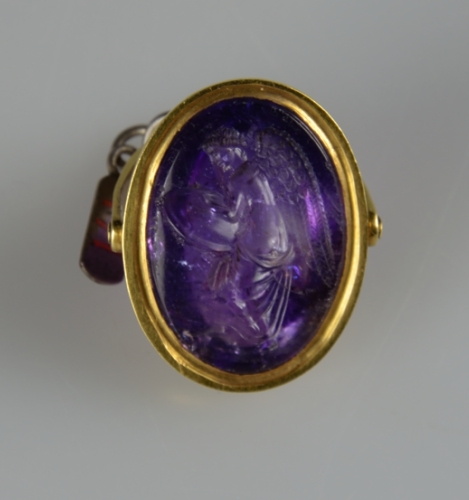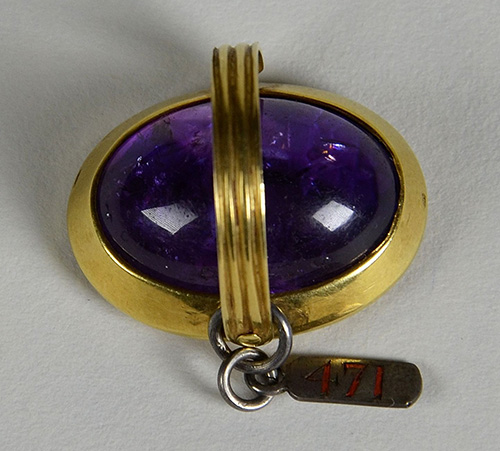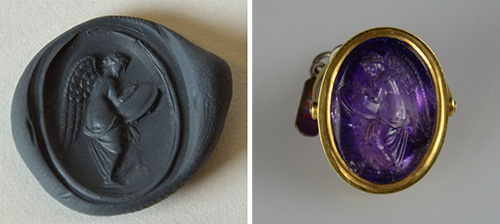Digging Through the Vaults: Rediscovery and Rehabilitation
Published
Categories
Author
Blog Post

Collector's ring with a large convex amethyst gem engraved with an image of Nike. Height: 2.2 cm Accession number: 925.83.6
Several months ago a colleague of mine and a curator from the European section were looking through a drawer of jewellery in the ROM’s Robertson Silver Storage Vault. From the corner of his eye he spotted a large convex amethyst gem set in a gold collector’s ring; examining it closer he saw that the stone was engraved with an image of a Nike writing on a shield. Not only that, a small brass tag with a red number punched on its side was attached to the ring. Struck by the material, shape of the stone, elegance and quality of the carving; he immediately thought it was ancient and dated to the late Hellenistic – early Augustan period, about 50 to 25 BC. He brought the engraved gem to my attention and so began my search to find out what I could about this splendid antiquity and how it came to rest in the European collection.
A few days later my friend phoned and gave me a crucial lead. He recalled seeing gems, set in collector’s rings with a similar type of brass tag attached to them, in the Wyndham Francis Cook Collection. Sure enough, looking through the catalogue of the antiquities in the Cook Collection (London, 1908), I found our gem on plate 7, No. 150. The catalogue entry described it as early Augustan and that it had been exhibited at the Burlington Fine Art Club’s Exhibition of Greek Art (1903) and illustrated in the accompanying catalogue (plate 110, M 78) and again described as an early Augustan work. Later when the Cook Collection was auctioned at Christie’s, London on July 14 to 16, 1925, Thomas Sutton, the ROM’s European buyer, purchased six lots for Charles Currelly (ROM’s first director); including the amethyst engraved with Nike (lot 394). The gem was poorly described in the sales catalogue, omitting its culture, date and a picture. Sutton had the objects shipped on July 29, 1925 and they cleared customs in Canada on August 24, 1925.
I began searching for more information. Sutton’s and Currelly’s subsequent letters made no mention of the gem and combing through the museum’s files, records and archives proved fruitless. However, there was still one more avenue to explore. Two exhibitions held decades ago may have included the gem. In 1950, Elie Borowski, then a ROM curator, organized a show titled Three Thousand Years of Glyptic Art. After digging through our Greek and Roman’s filing cabinets I unearthed Borowski’s working notes and a list of objects for his exhibition. Cylinder and stamp seals from the Middle East and engraved gems from Greece, Etruria, and Rome were displayed but not the amethyst gem. Later, in the early 1970’s when Neda Leipen, head of the Greek and Roman Department, reinstalled the Greek, Etruscan and Roman jewellery case, the amethyst gem was not cited in her label text.
I can only assume that someone thought the amethyst gem was modern and carved in 19th century. It was probably turned over to the European Department after 1925 but before Borowski’s exhibition in 1950. Both Borowski and Leipen were engraved gem experts and would have recognized it as being ancient. The gem was never catalogued or given a ROM accession number.
Through a chance encounter, a misplaced masterpiece of ancient glyptic art was rediscovered and rehabilitated. When, why and who transferred the gem to the European collection remains a mystery.




